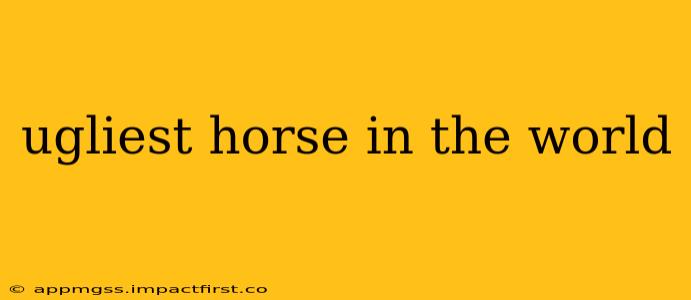The title "ugliest horse in the world" is, of course, subjective. What one person finds unattractive, another might find endearing. However, certain horses have garnered attention for their unique appearances, often leading to discussions about their place in the world of equine beauty. This article explores some of these horses and delves into why the concept of "ugliness" in animals is often more complex than it seems.
What Makes a Horse "Ugly"?
Before we look at specific horses, let's consider what constitutes "ugliness" in a horse. It often boils down to deviations from the perceived ideal equine form. This ideal, shaped by centuries of breeding and cultural preferences, usually involves:
- Proportions: A balanced body, with harmonious relationships between head, neck, torso, and legs.
- Features: A refined head, well-defined musculature, and a sleek coat.
- Conformation: Soundness of limbs and structure that contributes to ease of movement and overall health.
Horses deviating from these characteristics might be deemed "ugly" by some. However, these deviations can often be the result of genetic mutations, breed-specific traits, or even injury. This isn't a question of inherent ugliness, but rather a difference.
Horses Often Cited as "Ugly": The Contenders
Several horses have earned the dubious title of "ugliest" through online popularity and viral fame. These horses often possess features that depart significantly from the traditional equine aesthetic. It's crucial to remember that these horses are still individuals with unique characteristics and deserve respect. Some examples commonly mentioned include:
- Horses with unusual facial features: A horse with a disproportionately large head, misaligned features, or other unique facial characteristics might be considered "ugly" by some. These differences could result from genetic factors or even minor injuries.
- Horses with unusual coat colors or patterns: While some coat patterns are celebrated (like Appaloosas or Pintos), others might be seen as less desirable. Genetic mutations can lead to striking, unusual colors and markings that some may find less aesthetically pleasing.
It's important to note that no specific horse has been universally declared "the ugliest." The very concept is subjective and relies on individual preferences.
Is There a Scientific Basis for "Ugliness"?
There's no scientific classification of "ugly" animals. The concept is purely aesthetic and culturally influenced. What one society considers beautiful, another might not. Equine beauty standards, like those for other animals, are subjective and change over time.
Why We Should Rethink "Ugliest"
The search for the "ugliest" horse often overlooks the inherent beauty in diversity. These horses, with their unique appearances, remind us that beauty exists in various forms. Focusing on a horse's outward appearance often ignores its personality, temperament, and the potential contributions it could make.
H2: Are there any health implications related to unusual appearances in horses?
Yes, sometimes unusual appearances can be associated with underlying health concerns. For example, certain facial deformities might affect breathing or eating. Unusual limb conformations could lead to lameness or other mobility issues. It's crucial to remember that appearances can be an indicator of underlying health problems.
H2: Can "ugly" horses still be good riding horses?
Absolutely! The aesthetic qualities of a horse don't necessarily dictate its suitability as a riding horse. A horse's temperament, training, and soundness are far more important factors for determining its potential as a riding animal. A horse might have a unique appearance but possess a calm temperament and be perfectly sound.
H2: How are unusual-looking horses treated in the equine community?
Most responsible horse owners and the wider equine community prioritize a horse's health and well-being regardless of appearance. Many "unusual-looking" horses find loving homes and are cherished by their owners.
In conclusion, the quest for the "ugliest" horse is ultimately a subjective endeavor. While some horses may possess unique physical characteristics that deviate from established beauty standards, these differences don't diminish their value as individuals. We should celebrate diversity and appreciate the beauty of imperfection in all living beings.
